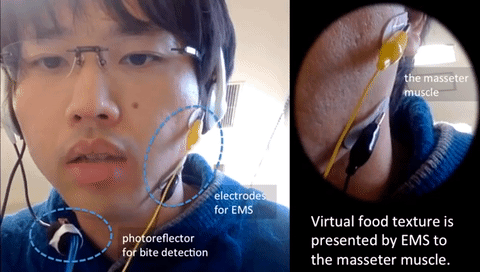
In this week's Abundance Insider: Chain-smoking robots, skin-healing electroactive polymers, and lip-reading AIs.
Cheers,
Peter, Marissa, Cody, Kelley, Greg, Sydney and AJ
P.S. Send any tips to our team by clicking here, and send your friends and family to this link to subscribe to Abundance Insider.
Face Electrodes Let You Taste and Chew in Virtual Reality
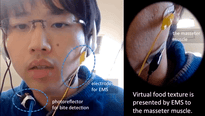
What it is: Researchers in Tokyo have successfully used thermal stimulation on the tongue to mimic flavors such as mint, spice or piquancy. A separate team from the University of Tokyo also succeeded in mimicking textures such as hardness and chewiness with external electrodes on the masseter muscle.
Why it's important: This particular research is targeted to help people on restricted diets stick to protocol and enjoy their food, but the bigger picture is that we're beginning to understand what drives sensory experience in the real world. What pain or anxiety treatments might be facilitated by better understanding the pleasure of, say, chocolate -- and what opportunities does that create for wearable technologies, or non-pharmaceutical interventions within healthcare? Expect more feedback loops between the real world and the technologies that enable truly immersive Virtual Reality. | Join the Discussion
Spotted by Marconi Pereira / Written by Jason Goodwin
Chain-Smoking Robot Studies Pulmonary Disease
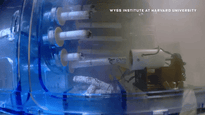
What it is: Scientists at Harvard's Wyss Institute built a chain-smoking robot to better understand the mysteries of pulmonary disease that plague smokers. The robot is designed to pass cigarette smoke into its lung-on-a-chip, mimicking how smoke passes through a human airway. The researchers tested two different chips -- one chip with cells containing pulmonary disease and the other chip without -- to observe how the two react differently to smoke. As a result of these tests, scientists have already found more significant inflammatory responses to smoke from the cells containing COPD. Testing on a robot not only better represents human responses to smoke than animal testing, it also eliminates many ethical concerns.
Why it's important: This research is just a glimpse at the profound implications that organs-on-a-chip and robotics will have on medicine. The accuracy, efficiency and consistency of these technologies enable researchers to accelerate the understanding of other mysterious chronic infections and diseases -- improving our ability to effectively prevent and treat these diseases. | Join the Discussion
Spotted by Aashay Mody / Written by Sydney Fulkerson
A Material From Shape-shifting Planes Could Heal Human Flesh

What it is: Inventors Mia Siochi and Lisa Scott Carnell have invented a high-tech gauze containing polyvinylidene fluoride -- the same material NASA refined for use in shape-shifting aircraft -- that has the unexpected ability to accelerate the human body's natural healing process. The gauze has natural electrical properties: when the polymer is put directly on skin and activated through body heat, it can mimic the effect of voltage devices used in hospitals to jolt cell migration. Seeing the material's potential to help astronauts heal wounds in space, the inventors handed the material over to NASA's Technology Transfer Program, which enables companies to inexpensively license NASA technology and "productize" it for a market of non-astronauts.
Why it's important: Peter's blog on materials science alluded to the coming materials science revolution, which will impact every field of technology and every aspect of our lives -- including medicine. Imagine first-aid pads made of this material in developing countries, on spacecraft and in other remote locations where traditional medical treatment poses logistical difficulties. | Join the Discussion
Spotted by Aryadeep S. Acharya / Written by Sydney Fulkerson
Planetary Resources Mines Luxembourg for $28 Million in Asteroid-Hunting Funds
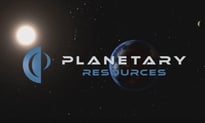
What it is: The country of Luxembourg has invested a total of $28 million (USD) in Planetary Resources ($12 million euros from Luxembourg and $13 million from the public investment bank SNCI). In addition to supporting the goal of launching the first commercial asteroid prospecting mission in 2020, Planetary Resources reports that Luxembourg will benefit from a strengthened local space industry through several key activities focused on "propulsion development, spacecraft launch integration, deep space communications, asteroid science systems, Earth observation product development, and mission operations."
Why it's important: That Luxembourg -- a country roughly the size of Rhode Island, heavily wooded and without any launch locations -- would invest in the commercial space sector is itself important. This vote of confidence in PRI's mission also demonstrates the many benefits that moonshots have beyond their stated goal. In this case, Luxembourg gets to fund the development of expertise and jobs essential to thriving in an exponential economy. | Join the Discussion
Spotted by Peter Diamandis / Written by Jason Goodwin
LipNet: Sentence-Level Lip Reading

What it is: What if machines could lipread better than humans? That's the premise of LipNet, the first lipreading model that can make its predictions at the sentence level. As the study abstract reads, "On the GRID corpus, LipNet achieves 93.4% accuracy, outperforming experienced human lip-readers and the previous 79.6% state-of-the-art accuracy." LipNet is the product of joint research by Google's London-based DeepMind team, the Canadian Institute for Advanced Research and computer scientists at the U.K.'s University of Oxford.
Why it's important: "Machine lip-readers have enormous practical potential, with applications in improved hearing aids, silent dictation in public spaces, covert conversations, speech recognition in noisy environments, biometric identification, and silent movie processing," the researchers write. Today, machine lip-readers can classify words, but not predict sequences of words (i.e. sentences). How will privacy, security and public communication change when this technology democratizes? | Join the Discussion
Spotted by Marconi Pereira / Written by Marissa Brassfield
Researchers Invent 'Perfect' Soap Molecule That is Better for the Environment

What it is: University of Minnesota researchers recently invented a soap molecule that could greatly reduce the number of chemicals used in cleaning products. The soap molecule, called Oleo-Furan-Surfactant (OFS), is made from natural products that are far better for the environment than conventional soaps and detergents. Because OFS is made from straight carbon chains from soybeans or coconut, this soap molecule is 'perfect' in the sense that it's readily biodegradable. The technology used to create OFS has been patented by the school and is licensed to Sironix Renewables as part of the U.S. Department of Energy's focus on catalytic technology to produce renewable chemicals.
Why it's important: The cleaning products industry is a multibillion-dollar industry, and this "perfect" soap molecule stands to disrupt incumbent commercial and consumer products. On a larger scope, using exponential technologies like materials science can dramatically reduce our environmental footprint, ushering us toward a future of abundance. | Join the Discussion
Spotted by Aryadeep S. Acharya / Written by Sydney Fulkerson
Italy's Largest Taxi Fleet Accepts Bitcoin

What it is: Cooperative RadioTaxi 3570 -- Italy's largest taxi fleet, with over 3,700 taxis roving the streets of Rome -- now officially accepts bitcoin, thanks to a partnership with Chainside. "We are not as conservative and opposed to innovation as we often described," said Loreno Bittarell, the founder of the Italian Union of Radio Cabs and president of RadioTaxi 3570. "We have always seen innovation as a growth stimulus. We want to give a strong signal to our competitors."
Why it's important: This taxi fleet is proactively disrupting itself by experimenting with exponential technologies, rather than appealing to regulators to slow the spread of disruptive market entrants like Uber and Lyft. Could this approach work in other locations, like London or New York, where taxicabs are a part of the cultural experience? | Join the Discussion
Spotted by Marconi Pereira / Written by Marissa Brassfield
4th Google Lunar XPRIZE Team Signs Launch Contract for Moonshot in 2017

What it is: Google Lunar XPRIZE competitor Team Indus has just received a launch contract to compete for the first private expedition to the moon. The team signed a deal with Antix Corp of India Space Research Organization for a launch on the Polar Satellite Launch Vehicle late next year. Other competitors include Moon Express, SpaceIL, and Synergy Moon -- and they're all racing to be the first to land on the Moon and perform certain tasks before the end of 2017. This is all in an effort by NASA to refocus on a return to the Moon as part of its wider space exploration plan.
Why it's important: The $30 million Google Lunar XPRIZE incentive competition has the potential to demonetize robotic space exploration on the Moon. Advanced Moon explorations could be our gateway to the rest of the universe, while simultaneously enabling us to make new breakthroughs in science, technology, resource utilization, and more. | Join the Discussion
Spotted by Peter Diamandis / Written by Sydney Fulkerson
Nanobionic Spinach Plants Detect Explosives, Pollution and Drought
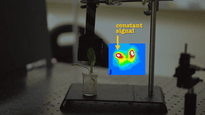
What it is: Researchers led by Michael Strano from MIT have embedded carbon-nanotube sensors into the leaves of spinach plants, allowing the plant to detect a wide range of molecules, from explosives that leech into the groundwater to "hydrogen peroxide, the explosive TNT, and the nerve gas sarin." When prompted by a laser, the leaf emits a near-infrared fluorescent light, which a small infrared camera attached to a smartphone or Raspberry Pi can then detect.
Why it's important: In principle, this sensor-laden spinach could be used to identify a wide range of pollutants and trace elements, detecting everything from drought to soil property changes. This is a big step towards digitizing and dematerializing the wealth of information that we know plants possess. With more and better data on which to apply machine learning principles and Artificial Intelligence, we'll see faster and bigger breakthroughs in environmental science, agriculture and human health. | Join the Discussion
Spotted by Aryadeep S. Acharya / Written by Jason Goodwin
What is Abundance Insider?
This email is a briefing of the week's most compelling, abundance-enabling tech developments, curated by Marissa Brassfield in preparation for Abundance 360. Read more about A360 below.
WANT MORE CONVERSATIONS LIKE THIS?
At Abundance 360, Peter's 360-person executive mastermind, we teach the metatrends, implications and unfair advantages for entrepreneurs enabled by breakthroughs like those featured above. We're looking for CEOs and entrepreneurs who want to change the world. The program is highly selective. Apply now for Abundance360 Summit if you'd like to develop an Abundance Mindset.
Know someone who would benefit from getting Abundance Insider? Send them to this link to sign up.







